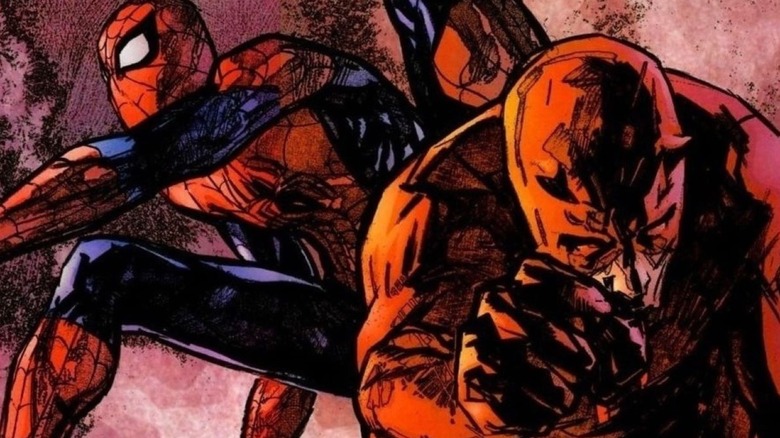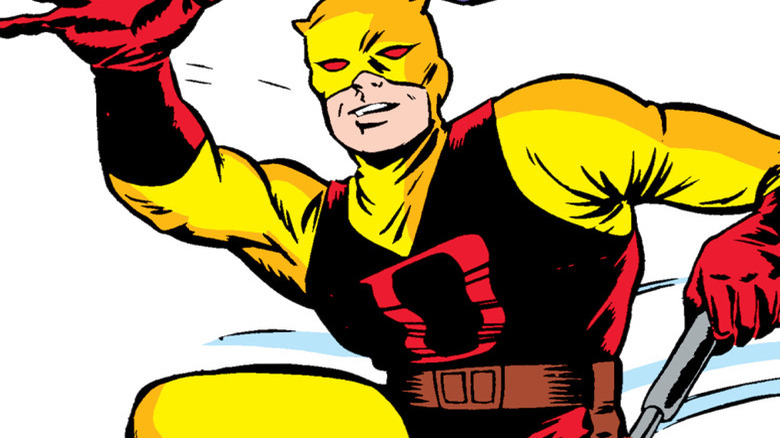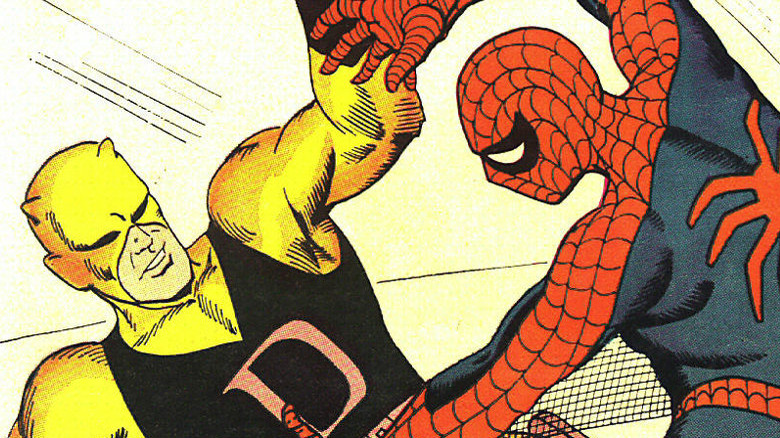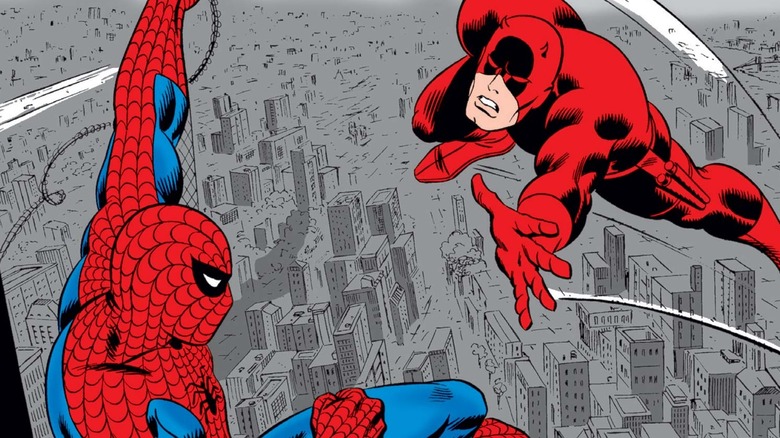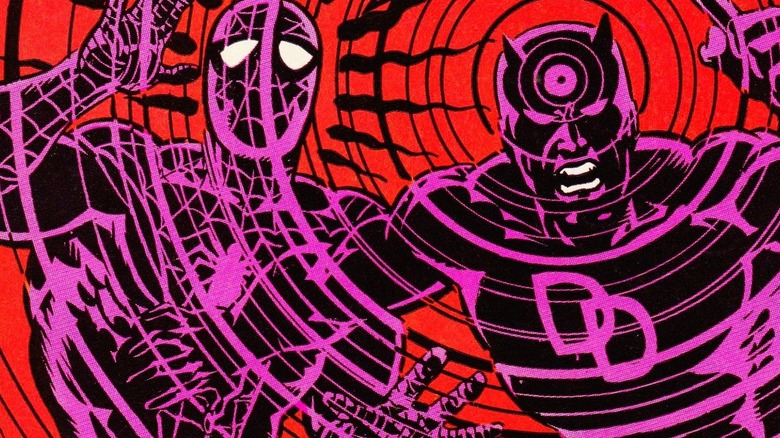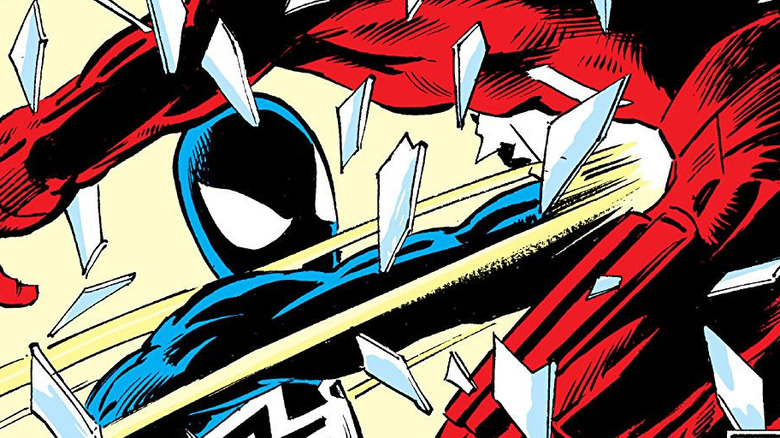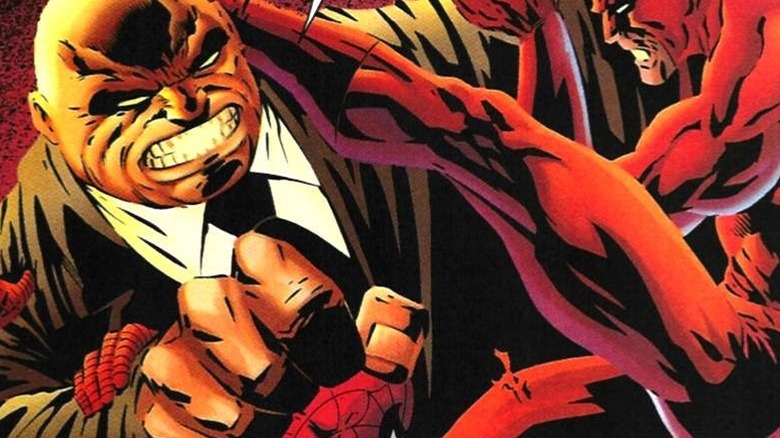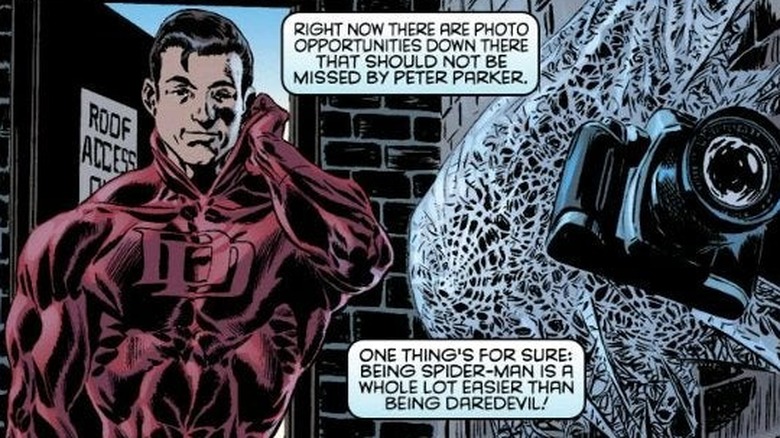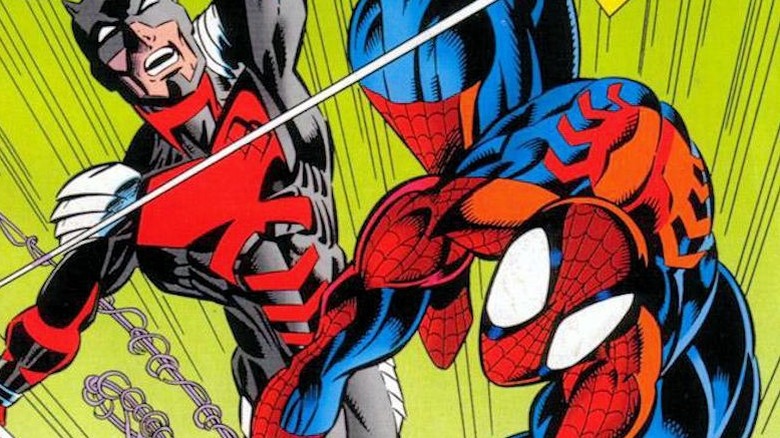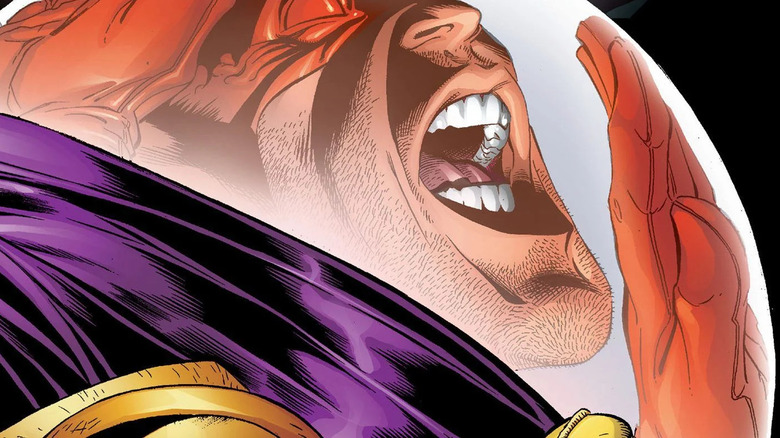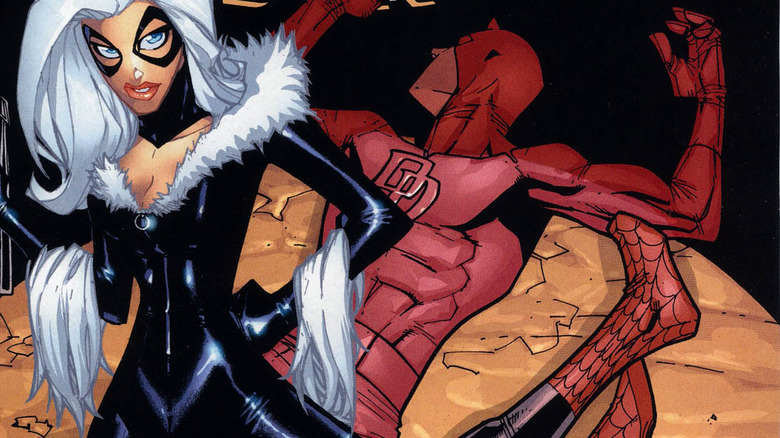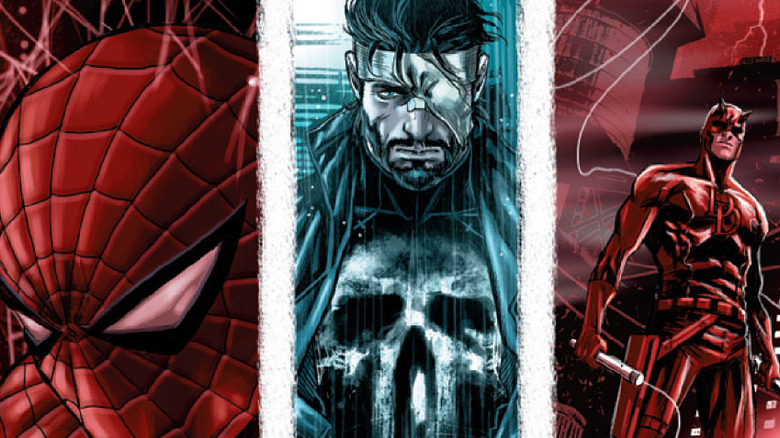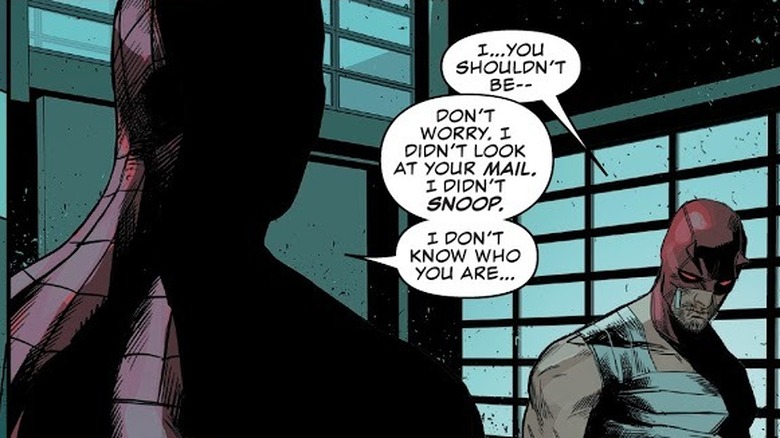The Untold Truth Of Spider-Man And Daredevil's Relationship
Spider-Man and Daredevil are two of the most well-known and beloved superheroes in their corner of the Marvel Universe. The amazing arachnid and the Devil of Hell's Kitchen are veterans when it comes to fighting crime on the streets. After all, keeping the neighborhood safe for the little guy is more up their alley than stopping world-ending threats from outer space.
Over the years, the two urban defenders have developed a strong bond that transcends their masked identities. Perhaps it's because of their overlapping areas of operations, or maybe it's their numerous shared characteristics and values. Either way, it's hard to imagine a Marvel Universe in which Spider-Man and Daredevil don't team up every now and then to take down some thugs or put a dent in organized crime.
That said, the road towards their personal and professional friendship wasn't always a walk in the park. In fact, early on in their respective careers, it seemed as though ol' Web-Head and ol' Hornhead could barely stand each other. Eventually, though, they grew to trust and respect each other — and at countless points in their lives, even lent a much-needed helping hand whenever the other was in a serious jam. Here's a look at the relationship between Spider-Man and Daredevil and why they work so well together.
Daredevil: A Spider-Man copycat?
Spider-Man made his spectacular debut in 1962's "Amazing Fantasy" #15 and became such a commercial success that he received his own eponymous title (still with the "Amazing" adjective) about half a year later. At the time, Marvel had been gaining a reputation — and enjoying much success — for its portrayal of superheroes as flawed and imperfect, as the late Stan Lee himself admitted in a video interview (via YouTube). Thus, when the time came to introduce another superhero to the growing Marvel roster, Lee decided that he and writer-artist Bill Everett should work on a protagonist with a disability.
And so, in 1964, "Daredevil" #1 hit the stands, featuring a yellow-clad superhero with a mysterious characteristic that, according to the cover, made him "different from all crime-fighters." His alter-ego Matt Murdock is even billed as "the most unusual hero of all." After flipping through the pages of the book, readers understood why: Because of a selfless act, an accident involving radioactivity takes away Matt's eyesight but amps up all his other senses. The blind youngster navigates through hardships and personal tragedies, growing up to become a lawyer by day and a colorful, acrobatic crime-fighter by night.
That said, the similarities between Spider-Man and Daredevil were too many to ignore: Both were shy bookworms who gained powers through radiation and were motivated to become superheroes due to the deaths of their father figures. "Daredevil" #1's cover even featured Spider-Man, further reinforcing their similar traits.
Spider-Man and Daredevil against the Ringmaster
It only took a few months before the two high-swinging superheroes crossed paths in the comic book pages. In 1964's "Amazing Spider-Man" #16, Spider-Man first meets Matt Murdock when the web-slinger ensnares a group of crooks attempting to escape with stolen loot. Spider-Man mistakenly (and understandably) assumes that Matt is nothing more than a helpless bystander in grave danger, unaware that he is secretly Daredevil.
Later, Spider-Man is tricked into showing up at a phony charity circus show where his appearance is advertised. It turns out to be nothing more than a ruse by the villainous Ringmaster and his Circus of Crime, who quickly bewitch Spider-Man and the show's spectators with his hypnotic hat in order to rob them. Fortunately, Matt and his friends Foggy Nelson and Karen Page are part of the crowd, and with Matt being blind, the hat's powers obviously don't work on him.
The blind lawyer slips away and suits up as Daredevil, only to come face to face with a mind-controlled Spider-Man. At the Ringmaster's behest, the two agile warriors briefly tangle until the Man Without Fear is able to help Spider-Man break free of the Ringmaster's control. Working together, Spider-Man and Daredevil make short work of the criminal crew. This short team-up plants the seeds of Spider-Man and Daredevil's friendship — but it won't be until many years (and quite a few misunderstandings) later that they get over their misgivings about each other.
From foes to friends
The two adventurers meet again in 1966's "Daredevil" #16. At this point, Daredevil is already sporting his now-iconic all-red costume. In this issue, Spider-Man makes a couple of mistaken assumptions about Daredevil that hints at just how much he trusts him at this point (hint: not very much). While the two superheroes are able to clear up their misunderstanding fast enough to work together and bring down the Masked Marauder, their less-than-cordial partnership ends up setting the stage for their subsequent encounters.
In 1967's "Daredevil" #27, for example, Daredevil gives Spider-Man a quick assist while fighting some street thugs to ask for his own help in tracking down Stilt-Man, but Spider-Man is less than enthused at the prospect of getting a hand that he didn't ask for. Meanwhile, 1969's "Daredevil" #54 sees Spider-Man accusing Daredevil of "blundering into [his] fight" — ironic since Spider-Man ends up interfering in Daredevil's conflict against the Sub-Mariner in 1971's "Daredevil" #77 out of spite and jealousy for Hornhead's seemingly light and problem-free life.
Their relationship appears to improve, albeit ever so slightly, in 1973's "Daredevil and the Black Widow" #103. While on assignment from the Daily Bugle to interview Daredevil and the Black Widow, Peter Parker (as Spider-Man) finds himself lending a hand in the crime-fighting couple's battle against the cyborg Ramrod. While Spider-Man's interaction with Daredevil here is brief, it does show that on some level, they've started to trust each other.
The blind leading the blind
Conventional wisdom states that the best way to understand what another person is going through is to walk a mile in their shoes. In a 1979 Spider-Man story, the web-slinger has the opportunity to better understand the world of someone like Daredevil — albeit unknowingly, since he wasn't aware of the Man Without Fear's secret identity at the time — after an encounter with the Masked Marauder renders him unable to see.
In "Spectacular Spider-Man" #26, Spider-Man barely manages to stop the villain and Tri-Man, his robot minion, as they pull off a robbery. Scared because of the sudden loss of his sight, Spider-Man nearly plummets to his death from a building, saved only by the timely interference of Daredevil. The next issue sees Daredevil helping Spider-Man cope with the physical, mental, and emotional consequences of his unexpected blindness. He also brings Spider-Man to a specialist, who helps him get a better understanding of what happened to him. Spider-Man spirals into near-hopelessness, at one point almost opting to reveal his secret identity to Daredevil in case something bad happens to him.
By the end of the three-part story, Spider-Man and Daredevil successfully stop the Masked Marauder's scheme, and Spider-Man's eyesight gradually returns. Even though Spider-Man's blindness wasn't permanent, the experience that the two men shared — with the blind leading the blind — certainly helped them improve the way they regard each other.
Coping with Jean DeWolff's death
The life of a superhero is filled with sacrifice and tragedy. And sometimes, the sense of grief and loss can be so overwhelming that it can make even the most righteous hero question exactly how justice should be dispensed. Spider-Man and Daredevil get the opportunity to reflect upon this starting in 1985's "Spectacular Spider-Man" #107, which kicks off a four-part story involving the brutal murder of one of Spider-Man's friends.
When Spider-Man hears about the death of police detective Jean DeWolff — one of the few operatives of the law who held him in high regard — he resolves to apprehend the person who took her life. Eventually, Spider-Man and Daredevil come face to face with the shotgun-toting Sin-Eater, the person responsible for DeWolff's murder. When it's revealed that the Sin-Eater is none other than DeWolff's fellow detective Stan Carter, Spider-Man almost completely loses it, nearly killing Carter himself. Daredevil stops him in the nick of time but almost dies the next day when he tries to stop an angry mob from killing Carter, who is now in the cops' custody. In desperation, Daredevil calls out to Spider-Man using his real name ("Peter!"), snapping the wall-crawler out of his rage in time to save both Daredevil and Carter from the mob.
After a brief heart-to-heart (during which the two heroes reveal their identities to each other), Spider-Man and Daredevil agree to let Carter have his day in court — and build a stronger sense of friendship in the process.
Under the shadow of the Kingpin
Originally starting out as one of Spider-Man's rogues, Wilson Fisk, aka the Kingpin, gradually develop a deep-seated enmity with Daredevil. Over the years, the formidable crime boss tangles with many members of the superhero community, but few have come close to the rivalry that Fisk shares with the webslinger and the Man Without Fear. In a similar vein, few supervillains can claim to have done as much damage to their rival heroes' lives — whether intentionally or inadvertently — as Kingpin has to both Spider-Man and Daredevil.
With the Kingpin's wealth and influence, it's no surprise that he has been able to put the knowledge of his hated foes' secret identities to devastating use. For instance, when he learns about Matt Murdock's dual life as Daredevil in the "Born Again" storyline, Fisk plays the long game, getting Matt disbarred, making him lose all of his material assets, and nearly succeeding in killing him while tarnishing Daredevil's reputation.
Meanwhile, Spider-Man's decision to reveal his real identity as Peter Parker to the public in support of the Superhuman Registration Act gives the Kingpin a reason to hire a sniper to kill him in "Amazing Spider-Man" #538. The assassin misses Peter and hits his Aunt May instead, leading to the events of "Back in Black" and an angry Spider-Man delivering a humiliating beatdown to an incarcerated Fisk.
Helping each other with personal troubles
A far cry from their early days of barely tolerating each other, the friendship between Daredevil and Spider-Man has reached the point where they can count on each other to get them out of a tight spot.
With all of the unfair accusations thrown his way, Spider-Man has certainly benefited from being friends not just with Daredevil but with his legal eagle alter-ego as well. In 2008's "Amazing Spider-Man: Extra" #1, for instance, Matt Murdock represents Spider-Man in court as the latter faces charges of murder, obstruction of justice, and other offenses. In a brilliant move, Matt establishes that since anyone can dress up and pretend to be Spider-Man — which he demonstrates in court, with the help of various superheroes such as Nightcrawler, Iron Fist, and Shang-Chi dressed up as the web-slinger — the burden of responsibility is upon the accuser to prove that it was really the genuine Spider-Man who committed all the crimes he's accused of.
Similarly, Peter Parker has also gone to great lengths to help protect his friend's secret identity and private life. In "Daredevil" Vol. 2, #25, Peter dresses up as Daredevil to help Matt prove that his alter-ego isn't guilty of damaging property. Ten issues later, in "Daredevil" Vol. 2, #35, Spider-Man immediately rushes to Matt's house to support him after the press discovers his secret and even helps Daredevil take down a rampaging Mr. Hyde.
Living on the edge in the '90s
The '90s was a grim and gritty decade for comics, especially for Spider-Man. Peter Parker was really put through the wringer in this era, with the Clone Saga and the re-emergence of Ben Reilly making Peter question if he is even a real person. It doesn't help that Peter is trying his best during this time to fight the growing darkness in his soul, brought about by recent tragedies and revelations in his life. He even considers abandoning his life as Peter Parker entirely, fully embracing the persona of the Spider instead. However, after realizing that he does need help, he turns to "the closest thing to a kindred spirit [he had] ever known": Daredevil (in a flashy, overdesigned '90s-era costume, to boot).
In "Amazing Spider-Man" #396, Spider-Man seeks out Daredevil, who staged the death of his alter-ego Matt Murdock. At Spider-Man's insistence, Daredevil spares some time for him and dispenses some words of not-so-wise wisdom while standing at Matt's fake grave: Let go of his life as Peter Parker and become Spider-Man full-time. While the benefits of Daredevil's advice to Spider-Man are debatable at best, this only serves as proof that at his lowest points, Spider-Man still considers Daredevil to be one of the few people who can understand him and lend him a helping hand.
The menace of Mysterio
In "Daredevil" Vol. 2, #7, an old foe of Spider-Man's makes one final attempt at relevancy by trying to take out the Man Without Fear. Predictably, Daredevil manages to foil his plan, but not without disastrous consequences. And when Matt is left to pick up the pieces of their confrontation, it is Spider-Man who helps him get back on his feet and fight another day.
Daredevil discovers that the chief architect of many of his recent life's troubles was Quentin Beck, aka Mysterio, one of Spider-Man's most persistent enemies. Motivated by a terminal diagnosis and wanting to pull off one final display of skill by defeating his archnemesis, Mysterio changes targets when he discovers that the Spider-Man running around at the time isn't the man he fought with but his clone. The dying villain set his sights on Daredevil instead — a "second stringer" like him, in his own words — and orchestrates both the arrest of Foggy Nelson and the murder of Karen Page by Bullseye's hand. However, Daredevil has had enough at this point, verbally ripping Mysterio a new one by calling his existence "counterfeit" and labeling him as nothing more than a "human Xerox." This leads Beck to pull out his last trick, a move he "stole" from Kraven the Hunter: He shoots himself.
In the next issue, Spider-Man spends time listening to Daredevil grieve at their usual meeting place and reminds him why he must carry on: Because he saves lives.
The Spider, the Cat, and the Devil
Both Spider-Man and Daredevil have had their fair share of romantic encounters. Among all of the women they've been involved with, though, Black Cat is perhaps one of the most intriguing. A fellow costumed adventurer who walks the fine line between hero and villain, Black Cat uses a combination of skills and charisma to pull off daring heists. While Black Cat has stronger romantic ties to Spider-Man, there is at least one occasion during which she and the Man Without Fear nearly hook up.
In "Amazing Spider-Man" Vol. 1, #677, Spider-Man, Daredevil, and Black Cat find themselves entangled in a ploy that pits them against one another. As the three of them investigate, the attraction between Daredevil and Black Cat continues to grow, culminating in a passionate kiss in "Daredevil" Vol. 3, #8. It is eventually revealed, however, that Black Cat was actually hired to steal an important device in Daredevil's possession. Nevertheless, she changes her mind at the last minute and chooses to warn Daredevil that there's a criminal organization keeping tabs on him.
Interestingly, this isn't the first time Daredevil gets roped into helping Spider-Man and Black Cat on a mission. As Matt Murdock, Peter Parker asks him to help get Black Cat out of trouble after she is accused of murder in the limited series "Spider-Man/Black Cat: The Evil That Men Do."
Their mutual frenemy, Frank Castle
Despite being good friends, Matt Murdock and Peter Parker don't always see eye to eye. They do agree on one thing, though: The Punisher is bad news. Separately and together, Spider-Man and Daredevil have attempted to put an end to Frank Castle's violent vigilante activities quite a few times. On at least one occasion, however, they were forced to work with him for the greater good, much to Spider-Man's chagrin.
In the "Omega Effect" storyline, Daredevil enlists the aid of Spider-Man, the Punisher, and the latter's ally, Rachel Cole-Alves, in preventing the Omega Drive — a powerful physical repository of information about all the biggest criminal organizations on the planet — from falling into the wrong hands. In the end, after a showdown with members of the Megacrime syndicate (and a failed betrayal by Cole-Alves, who wants access to the drive for her own anti-crime crusade), Daredevil hands over the Omega Drive to the Fantastic Four for safekeeping.
As the webslinger himself tells Daredevil: "Know how you can tell we're friends, Magoo? Because in order to save your hide, I just teamed up with the Punisher."
A bond beyond their masks
For their own reasons and through their own means, both Spider-Man and Daredevil have been able to put the proverbial genie back in the bottle in terms of their secret identities. Sadly, these events mean that Peter Parker and Matt Murdock no longer know each other's dual identities. Fortunately, neither development undoes their years of friendship in the slightest.
In the case of Spider-Man, he is able to erase the world's knowledge of him being Spider-Man (and save the life of his Aunt May) at the cost of his marriage in the much-hated story "One More Day." Daredevil has his own "One More Day" moment, sort of, in "Daredevil" Vol. 5, #20, when the Purple Man's children combine their powers to make the world forget who Daredevil really is.
That said, the two heroes have proven that they still respect and value each other as much, if not more. In "Daredevil" Vol. 6, #5, when Spider-Man asks Daredevil to cease his vigilante activities after he accidentally gets someone killed, Hornhead complies without much argument. And in "Daredevil" Vol. 6, #23, Spider-Man (while still unaware of Matt's secret identity) helps him intimidate the Kingpin and even receives a grateful hug from Daredevil for his trouble.
